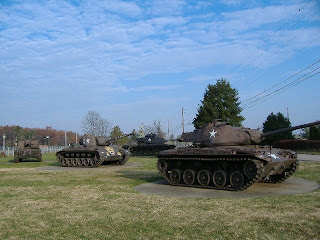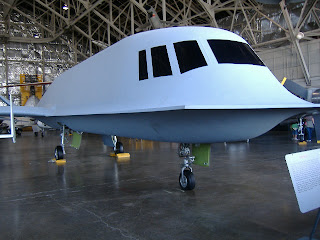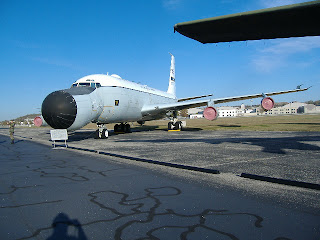Leaving Ft. Knox we drove on state and county highways heading to Evansville to find a motel. It is called the Kentucky Scenic By Way and parallels the Ohio River.
Stephen Foster was born and grew up in this area of Kentucky. Kentucky hills, horse and cattle ranches with lots of white fences, tobacco processing plant, acres of farm land,and some manufacturing. We stopped for lunch at a restaurant in one of the small towns. We have quilt blocks on our barns in areas of Iowa, but in this area of Kentucky they have a whole quilt painted on their barns!
A sign advertising "soda blasting" indicates that they use baking soda instead of sand to clean surfaces. It leaves a coating on the metal that prevents immediate rust from forming. This gives more time to put a finish on the metal.
We drove through snow flurries for the last few hours of our trip that day.
Indiana
A sunny, cold and windy day to drive north on Highway 41 through the Indiana countryside. We filled up with the cheapest gas on the trip--$1.569! In and out of Eastern Standard Time as we drive along the Wabash River valley.
North of Vincennes is an area with orchards and acres of melons and vegetables. Fields are harvested and all the Wholesale & Retail Farmers Markets are closed for the season.
We did see signs of the season---truckloads of Christmas trees!
Terra Haute
The Clabber Girl Museum was easy to find. Follow Highway 40 which went around their huge County Court House and into Wabash Avenue. On the corner was the tall building housing the Museum, corporate offices, gift shop and a restaurant.
 Later as we drove off we could see that the warehouses for this company took up a couple of blocks. Inside the building is finished in a beautiful wood paneling with exhibits of kitchens from different eras and personal memorabilia and information of the owners, the Hulman Family. They were German immigrants involved in general merchandise & grocery business expanding to include almost anything that could be sold.
Later as we drove off we could see that the warehouses for this company took up a couple of blocks. Inside the building is finished in a beautiful wood paneling with exhibits of kitchens from different eras and personal memorabilia and information of the owners, the Hulman Family. They were German immigrants involved in general merchandise & grocery business expanding to include almost anything that could be sold.Some of the products they manufactured were Hulman & Co spices & coffee, catsup, jams, peanut butter and apple butter. Canned goods were packed fresh across the country for shipment. Their brands were Dauntless, Farmers Pride, Crystal, Rex Coffee & Tea and Hulco Brand.

This pneumatic tube system was designed to send orders to every floor of the building complex. It was used until 2002 when a centralized computer system connected the buildings!
The Baking Powder War
In the 1850's ashes from the wood burning kitchen stoves were used to make lye soap and pearlash. Pearlash mixed with an acid like sour or clabbored milk worked as a leavenor for baked goods like bisuits, cakes and quick breads.
Baking Powder was invented in 1859. The chemical leavenor was a big hit with housewives. Manufacturers fought for distribution rights. At least 100 brands were available. One company that used a cream of tarter base spread wild accusiations regarding the safe use of the ingredients and health issues. They printed "official" looking scientific articles to sway the consumers. There were many closed factories and buy-outs. This was called The Baking Powder War!
Clabber Brand was one of the brands that survived along with Rumford. Both were manufactured by Hulman Company. The name was changed to Clabber Girl to make it consistant with the Food & Drug Act in 1906. It stated that the label be consistant with the contents. There was no clabbered or milk products in the product so Brand was dropped and Girl was added to the label.

This was an unusual antique electric mixer on display. It looked like 2 egg beaters with an electric motor attatched!
Racing Family
Herman Hulman raced bicycles in 100 mile races in the 1800's! They were the ones with the large front wheel and very small back wheel. In fact, they had bicycle racing clubs and we think the Tour de France is so great!!
Tony Hulman, Jr bought the Indianapolis Raceway after WWII from Eddie Rickenbacker, the WWI flying ace. It was run down, but he brought it back to where it is today. The family still owns it!
Back on the Road headed West
Had lunch in another small town cafe on way to the Interstate. Then it was through Illinois farmland for a stay at the Super 8 at Galesburg.
We heard about snow in Southern Iowa, but only saw the accumulation on the side of the road and in the fields until after we were home and unpacked! Then we had our snow flurries!
Thanking the Lord for the adventure of another safe road trip!
Prairie Schooners








